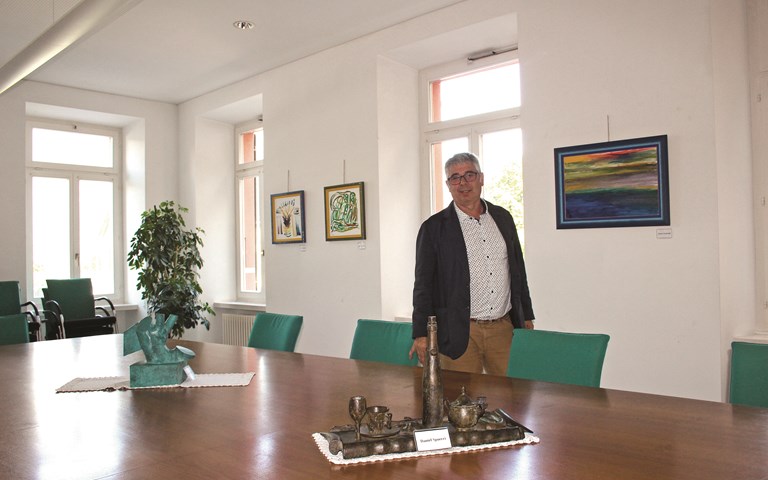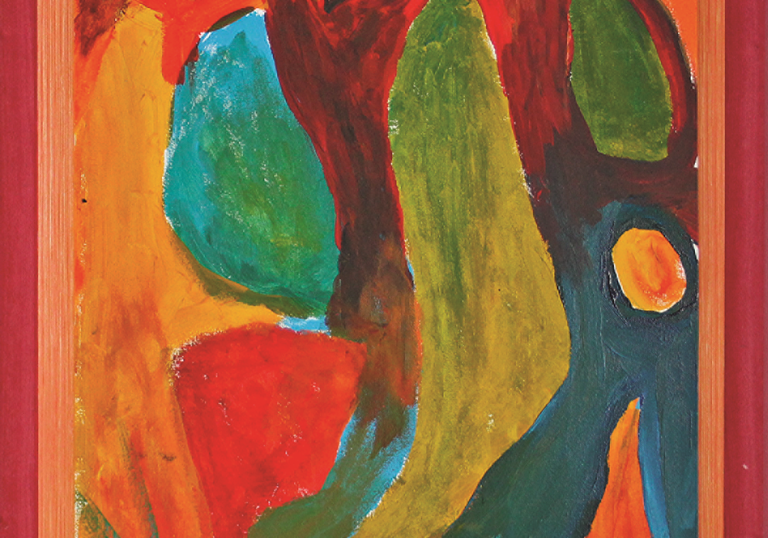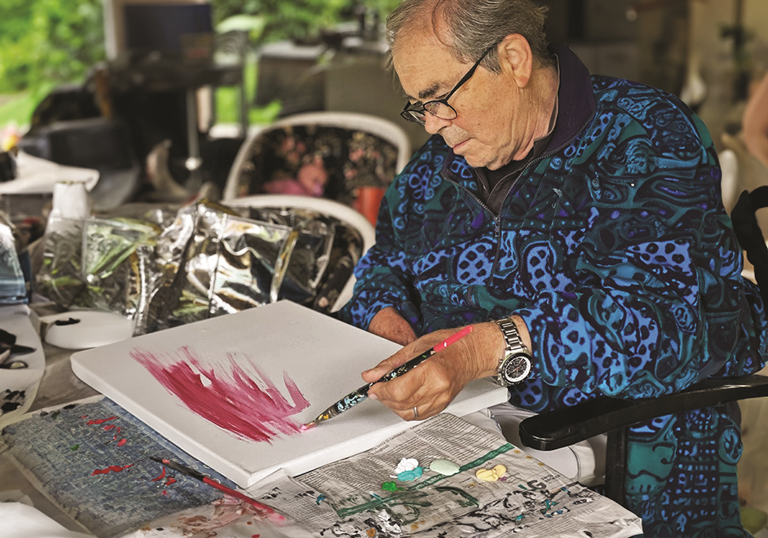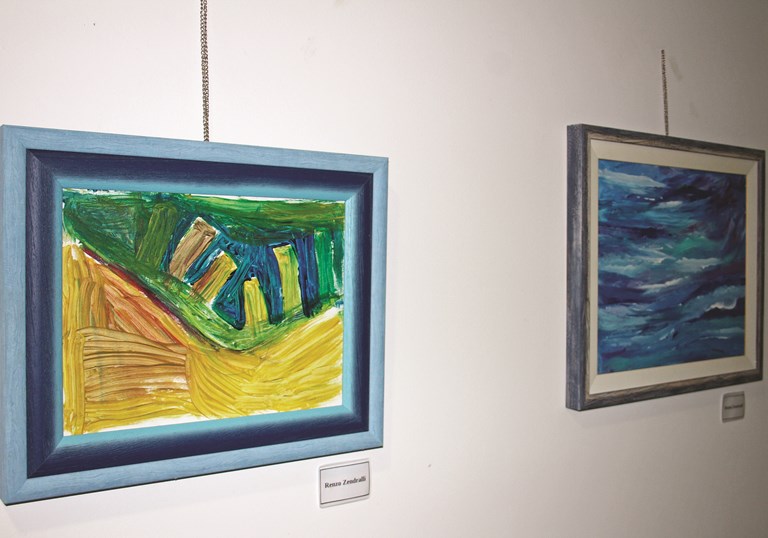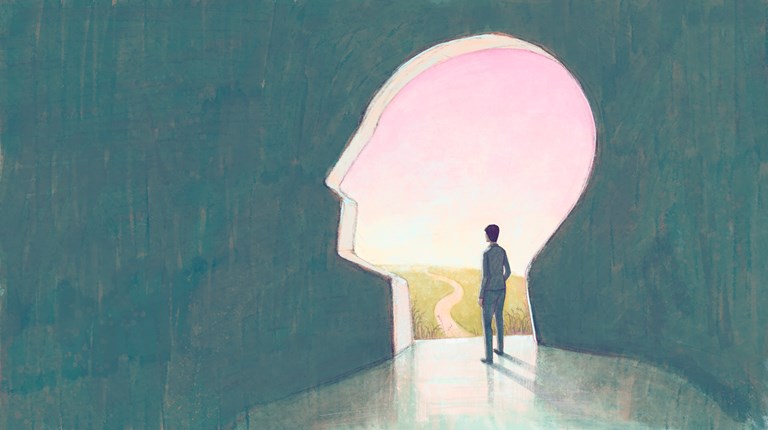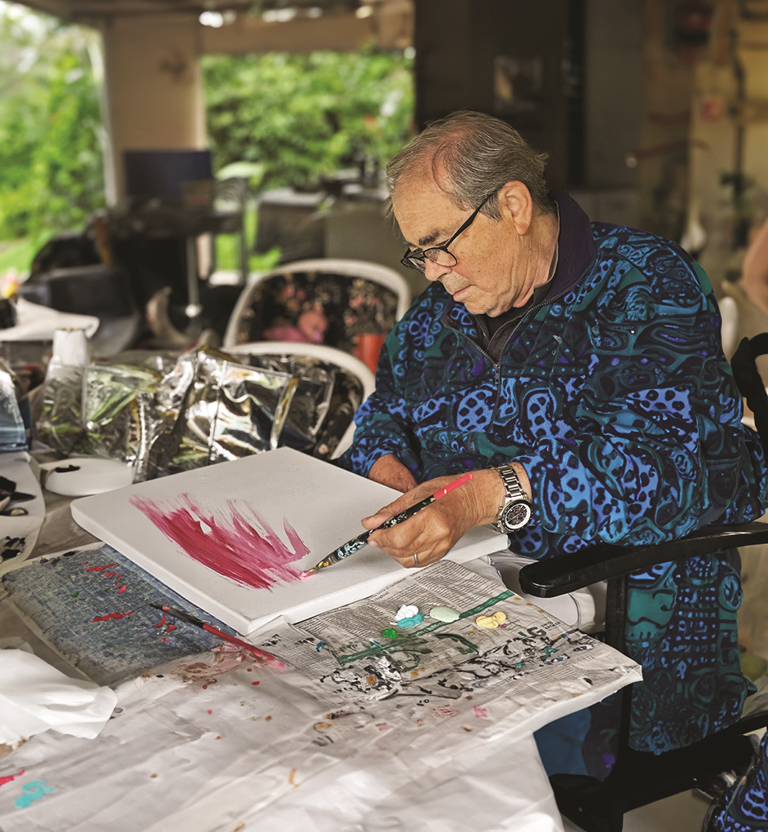
Talking with colours
One day you are playing golf. You think that life has given you many satisfactions. You are a respected manager and an important artist and personality of culture. You live with a woman who loves and loves you. You can enjoy the sea breeze at the helm of your boat and travel the world. True, years have passed, yet you still feel in harmony with the world around you.
Then, suddenly, you find yourself on the ground, your limbs and tongue don’t respond anymore. You start to lose consciousness. You may think it’s over. Instead, your second life begins. It is more tiring than the first one, you are sitting in a wheelchair, you are struggling to express yourself, you have to do rehabilitation. But you decide not to give up and you find a new way to express yourself. It’s made of shapes and colours. It’s the language of art. This is the story of Renzo Zendralli. We made it to tell from his vivid eyes and the voice of his wife Nadia.
For him it is like a self-therapy, as if through the paintings he presented himself.
We’ll meet you at the Bistrot in Grono. Renzo Zendralli, 78, studied as an engineer and a life spent at the helm of Antonini & Ghidossi SA, general enterprise of Bellinzona, arrives in his wheelchair pushed by his wife Nadia. Now, she is his voice, she is the interpreter of his memories, his gestures and his expressions. A stroke in 2012 caused a right-sided paresis and aphasia and prevents him from speaking as he wishes.
Let’s start with today, from the Von Mentlen Juvenile Education Centre in Bellinzona, where there is the exhibition that hosts a selection of works by Zendralli and some famous artists of his collection. How did the idea come about?
“Renzo - explains his wife Nadia - knows the director of Von Mentlen (Vito Lo Russo) since Vito was a collaborator of a company that worked with Antonini & Ghidossi SA. Vito then changed professional path but has always held Renzo in high esteem, who also took care of the restructuring of the institute. Therefore, when one day they met, he said that it would be an honor to exhibit his paintings and that it would be a useful opportunity for the young people of the centre, to understand the value of art and open the structure to the public to make it known outside.”
The works are exhibited in some rooms and some corridors on the ground floor of Von Mentlen and the exhibition was curated by the operator in the art sector Vito Calabretta. The exhibition, however, is the result of a larger project.
“Yes, Calabretta is carrying out a research project (“Geographies of expression - Politics of subject, form and body”) to understand and describe the role that art plays in the life of Renzo: first collector, now painter, but it is as if it is the red thread that holds together an existence. For him it is like a self-therapy, as if through the paintings he presented himself, the world that he has inside and that otherwise he is unable to express.”
It was like a tsunami. He was 67 years old, spoke five languages, loved to travel and suddenly lost all his points of reference.
Back to 2012. How has your life changed?
“After June 7, 2012 - says Mrs Nadia, remembering the date carved indelibly in the existence of the copy - it was like a tsunami.
He was 67 years old, spoke five languages, loved to travel and suddenly lost all his points of reference. He stayed between life and death, surviving with a hemiplegia on the right side and aphasia that does not allow him to speak correctly. He did rehab and speech therapy, but the neurologist said he had to cultivate his passions. We started traveling again, then one day he told me to go to the Coop Edile. He showed me the department of canvas and paint colours. He bought everything and once home he went into the garden and started painting on the marble table. He represented tall buildings but they were poised. He communicated the unstable balance in which he felt.”
When was the passion for painting born?
“As a child he dabbled with watercolours and drawings, but then, after studying engineering, art was experienced as an amateur and collector, meeting and attending gallery owners and artists, promoting young talents. In collaboration with Luigi Cavadini, he created a space in Bellinzona dedicated to the selection of young artists who were given the opportunity to exhibit. However, in adulthood he had not painted anymore.”
What are his favourite painters?
“He always had a passion for futurists in the eighties promoted an exhibition on Depero in Bellinzona. Then he collected works by exponents of Nouveau Réalisme: César, Arman, Spoerri, of the Italian post vanguardies: Isgrò, Rotella, Vaccari, of emerging Swiss artists: Beretta, Amstutz, Fiorini, and also works of other names of art: Paolucci, Morlotti, Dobrzanski. But above all many of them, as Spoerri became friends, also for the common acquaintances with Mario Botta.”
What inspires his work?
“In the beginning, his paintings reproduced buildings and prevailed geometric shapes, then he moved on to landscapes. What has never changed is the vitality that its colours express. They are never dark and give joy. From the colours of the Tuscan countryside to the blue of the sea. This also expresses his memories of travel, his passion as a skipper. We were on Etna in a period of eruption and those strong colours were transmitted on to the canvas. Inside, he still has a colourful world and wants to communicate that, even now, he continues to appreciate the life and beauty of art and nature. In these years he has created over two hundred paintings.”
Renzo’s brother Sandro also devoted himself to painting. A family passion?
“Yes, there must be something in the family. They are patricians from Roveredo but were born in Mendrisio, because their father was a stationmaster and travelled around Ticino. For a certain period, they also lived in Faido and it was there that his passion for Inter was born, he used to go on training camps there. His brother Sandro, after a life as an architect, turned to painting, albeit in a more professional manner. Moreover, in Roveredo, a cousin of theirs was famous because he could imitate the great painters. Renzo was an engineer but always had an artistic spirit: a passion for classical art and paintings.”
Keep traveling and visiting museums, is the wheelchair a problem?
“I have to say that the sensitivity to remove architectural barriers has increased everywhere: in Switzerland, Italy, France and England. We were also at the Louvre in Abu Dhabi and there was also the fast lane, the shuttle. At the temples of Agrigento they let us in by car. Yes, we can continue to travel and see the masterpieces even if Renzo is in a wheelchair.”
We take our leave of Mrs Nadia and her husband. We look at him one last time in the eyes, they are eyes that speak, that preserve the colours of the summers as a boy in Faido, the canvases of friends’ painters, trips on the slopes of the volcano and regattas between the waves. Colours ready to turn into paintings on canvas.
Renzo Zendralli
Year of birth: 1945
Profession: Engineer
After studying engineering, for many years he was director of the general enterprise of Bellinzona, Antonini & Ghidossi SA. He was a board member of the insurance company Pax. Philanthropist and art lover, he has been promoter of exhibitions and events to enhance young artistic talents.
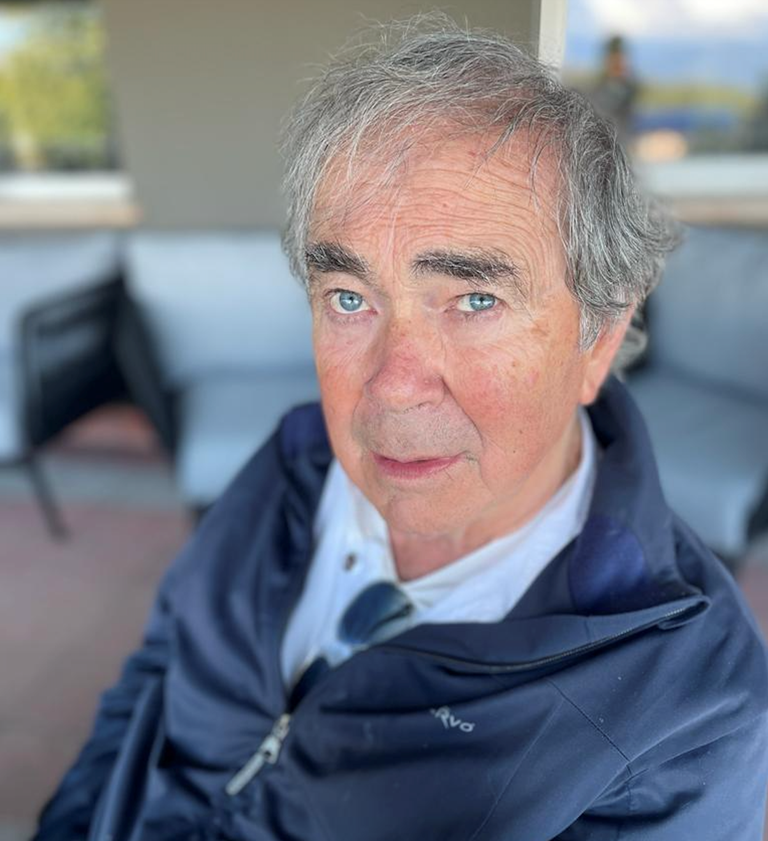
Von Mentlen Foundation Educational Centre for Minors
The CEM welcomes minors of both sexes, between 6 and 18 years who, for personal or family difficulties, need educational support and protection in the short, medium and/or long term, day or residential, outside their family of origin.
The beginning of the activity of Von Mentlen, located in Bellinzona, in Via Athos Gallino 4, dates back to 1911, following the testamentary dispositions of its founder Valeria von Mentlen-Bonzanigo, who devoted all her substances to the creation of a shelter for children.
In the 1990s, the institute underwent a major renovation and modernization with the subdivision of the spaces into two distinct blocks: the housing unit and the building that houses the elementary school “Differentiated school unit” managed directly by DECS. The institute is authorised as an Educational Centre for Minors (CEM).
istvonmentlen.ch
